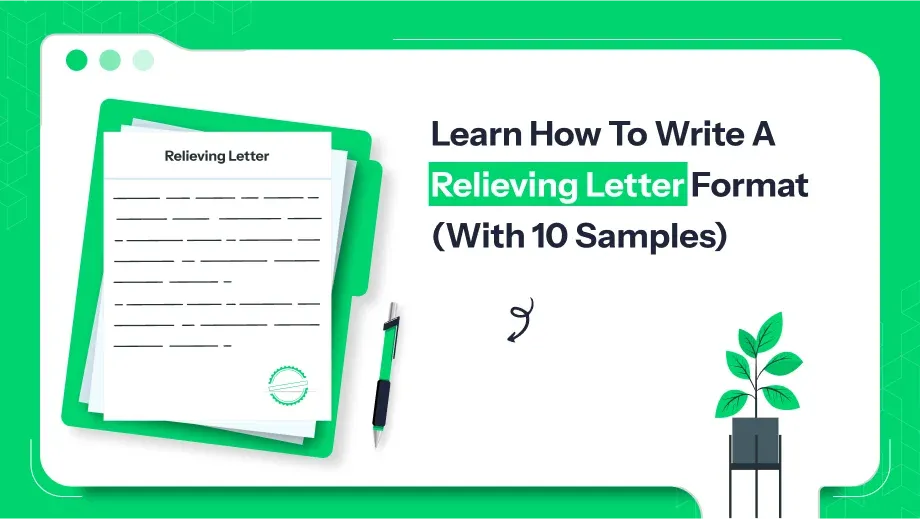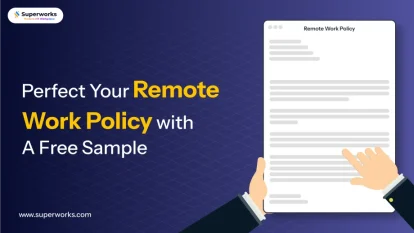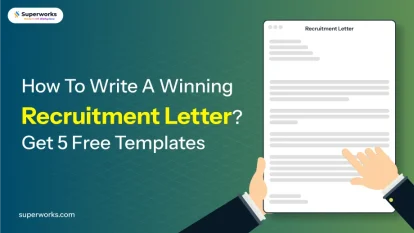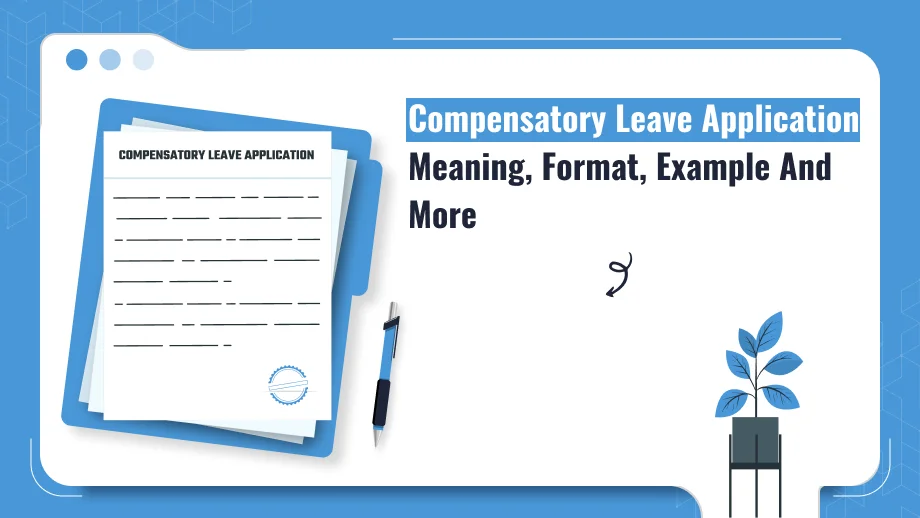You send a relieving letter request to your HR or reporting manager after your resignation letter is accepted. Keep it short and professional. Mention your last working day and ask for a formal relieving letter to complete your exit process.
Grab a chance to avail 6 Months of Performance Module for FREE
Book a free demo session & learn more about it!
-
Will customized solution for your needs
-
Empowering users with user-friendly features
-
Driving success across diverse industries, everywhere.
Grab a chance to avail 6 Months of Performance Module for FREE
Book a free demo session & learn more about it!
Superworks
Modern HR Workplace
Your Partner in the entire Employee Life Cycle
From recruitment to retirement manage every stage of employee lifecycle with ease.


Seamless onboarding & offboarding
Automated compliance & payroll
Track performance & engagement
Learn How To Write A Relieving Letter Format (With 10 Samples)
- relieving letter sample
- 10 min read
- July 17, 2023
As an HR, you have to write some relieving letters for your employees more often, and at such a time, you most probably would fail to find them in your spreadsheets. And at such a time, when you have lost without any thoughts, like from where you should start writing such letters, you really need a relieving letter format PDF.
Because when you have a detailed formal letter template, you can write as many relieving letters as you want. But what is it really? and why is it that crucial for official purposes?
A relieving letter format is an official document that is issued by the employer when they accept their employee’s resignation. The letter is to confirm the status resigning employee, by saying “your resignation has been accepted by the company.”
In this letter, the employer by putting out all the resignation dates and notifying your employees that they have been released from all duties. Companies should consider this letter as crucial as they consider the job application letter format.
In today’s times, you have to provide relieving letters to answer resignation letters, because through that you can easily clear up things like;
- Full and final settlement,
- Confirming the notice period, and
- Helping the employee join a new employer without delays.
In this post, you’ll find:
- A proper & best relieving letter format that’s simple to follow
- 10+ real-life relieving letter samples
- Tips on when and how to send them
- Answers to common HR questions about the process
So, whether you’re drafting it for the first time or need fresh job relieving letter formats for different situations, you’ll get all the details right here — in one place.
Ready? Let’s get into the format first.
Note: You can download directly from here and edit as per your need.
- Relieving Letter Format
- Top 10 Relieving Letter Format
- 1. Voluntary Resignation – Standard Relieving Letter
- 2. Immediate Relieving Letter (Notice Period Waived)
- 3. Contractual Employment Completion
- 4. Performance-Based Exit (After Resignation)
- 5. Resignation Due to Health/Personal Reasons
- 6. Relieving Letter with Experience Confirmation
- 7. Short Relieving Letter Format (Simple Cases)
- 8. Letter for Intern or Temporary Employee
- 9. Internal Transfer Relieving Letter
- 10. Termination-Based Relieving Letter (With Professional Tone)
- Why Relieving Letter Important?
- Some More Tips,
- Wrap Up,
Relieving Letter Format
A relieving letter format always follows a clear and professional tone. It confirms the employee’s resignation, states the resignation letter date after the subject line, and certifies that all duties have been handed over and the notice period is complete. HR teams must keep the relieving letter sample simple, using a consistent structure across different cases.
Such of formal document can be modified depending on the reason for exit — whether the employee left voluntarily, completed a contract, or was let go even after the post serving notice period. Always ensure it reflects the right tone & contains all employee information like joining date, last working date, and the employee’s job title, just like the internship certificate format.
Top 10 Relieving Letter Format
Each sample of relieving letter from employer below follows a proper letter format with clear employment details, confirmation of resignation letter, full and final settlement, and a professional tone suitable for HR records and future employers.
1. Voluntary Resignation – Standard Relieving Letter
Subject: Relieving Letter – [Employee Name]Dear [Employee Name],
We acknowledge the receipt of your resignation letter dated [DD/MM/YYYY]. The management has accepted your resignation, and your final working day with [Company Name] is confirmed as [Last Working Date], post serving your full notice period.
We confirm that you have completed all the duties assigned to you and handed over your responsibilities appropriately. Your full and final settlement will be processed as per company policies.
We appreciate your contributions during your tenure and wish you all the success in your future endeavors.
Warm regards,
[HR Manager’s Name]
Human Resources
[Company Name]
2. Immediate Relieving Letter (Notice Period Waived)
Subject: Relieving Letter – Immediate ReleaseDear [Employee Name],
Your resignation letter dated [DD/MM/YYYY] has been reviewed [just as we have revied your job relieving letter format] & accepted by the management. Upon your relieving letter request, you are being relieved from your services effective [Today’s Date].
You are not required to serve the standard notice period, and all internal property handovers and full and final settlement processes have been initiated.
We value the time you spent with us and wish you success in your future roles.
Best regards,
[HR Manager’s Name]
[Company Name]
3. Contractual Employment Completion
Subject: Job Completion Relieving LetterDear [Employee Name],
This letter confirms your successful completion of the fixed-term contract signed with [Company Name]. Your final working date as per your request letter will be [Mention the Last Date].
You are being relieved from all duties assigned under the terms of your agreement. Your full and final settlement will be initiated and completed within 10 working days.
Thank you for your services. We wish you the best in your future endeavors.
Sincerely,
HR Department
[Company Name]
4. Performance-Based Exit (After Resignation)
Subject: Relieving Letter Following ResignationDear [Employee Name],
Your resignation letter submitted on [DD/MM/YYYY] has been accepted. You served in the position of [Job Title] until [Last Working Day], fulfilling your responsibilities during the notice period.
We confirm that you have cleared all internal formalities and completed your full and final settlement.
We recognize your contributions and wish you success in the future.
Warm regards,
HR Manager
[Company Name]
5. Resignation Due to Health/Personal Reasons
Subject: Relieving Letter – [Employee Name]Dear [Employee Name],
We understand and accept your resignation letter dated [DD/MM/YYYY], citing personal reasons. You are relieved from your role as [Job Title] effective [Last Date].
We confirm that all official document clearances are complete, and the full and final settlement is in process.
We hope your circumstances improve soon and wish you the very best in your future endeavors.
Best regards,
[HR Manager]
[Company Name]
Stop shuffling through papers to get a relieving letter format!
Make your offboarding easy – with ready letters!
6. Relieving Letter with Experience Confirmation
Subject: Relieving & Experience Confirmation LetterDear [Employee Name],
We acknowledge your resignation letter dated [DD/MM/YYYY]. You served in the capacity of [Job Title] from [Joining Date] to [Last Working Day].
During this time, your performance met expectations, and you have been an asset to our team. You are hereby relieved of your duties post completion of your notice period, and all internal processes, including final settlement, are underway.
We wish you growth and fulfillment with your new employer.
Sincerely,
[HR Department]
[Company Name]
7. Short Relieving Letter Format (Simple Cases)
Subject: Short Relieving LetterDear [Employee Name],
This letter is to confirm that your resignation letter has been accepted. You are relieved of your duties from [Company Name] as of [Last Working Date].
We wish you success in all your future endeavors.
Kind regards,
HR
[Company Name]
8. Letter for Intern or Temporary Employee
Subject: Relieving Letter – Internship CompletionDear [Employee Name],
We are writing to confirm the successful completion of your internship at [Company Name], which commenced on [Start Date] and concluded on [End Date].
You are officially relieved from your duties, and your contribution to the assigned projects has been appreciated.
Best wishes in your academic and professional journey ahead.
Sincerely,
HR Department
9. Internal Transfer Relieving Letter
Subject: Internal Transfer – Relieving ConfirmationDear [Employee Name],
Following your internal transfer request, you are hereby relieved from your duties at the [Previous Department/Location] effective [Date].
You will assume your new responsibilities at [New Department/Location] starting [Date]. This transition is treated formally in our human resources records.
We trust that you will continue contributing with the same dedication.
Best regards,
HR Manager
[Company Name]
10. Termination-Based Relieving Letter (With Professional Tone)
Subject: Relieving Letter – Post TerminationDear [Employee Name],
Following the company’s decision regarding your termination, this letter serves as a formal confirmation of your release from employment effective [Last Date].
All official document procedures and internal clearances have been completed. Your full and final settlement will be processed in line with your contract.
We wish you well in your future roles.
Sincerely,
HR Department
[Company Name]
These templates are meant to reduce errors, save time, and maintain consistency in HR documentation. Whether you’re dealing with a relieving letter, dear employee, contractual staff, or previous employer records, these formats keep it simple and professional.
Why Relieving Letter Important?
A relieving letter sample for employee isn’t just another piece of paper. It plays a key role in an employee’s career transition and is equally important for the HR manager, the previous employer, and the new employer, just like the performance appraisal format is for the companies.
Here’s why it matters so much:
1. Acts as an Official Record
A relieving letter format is an official document that a previous employer will issue, and confirm the employee’s exit from the organization. Furthermore, it will have details regarding employee address, employee date, issuance date, and more.
It verifies that the resignation letter was accepted and that the employee completed their duties responsibly. And just like that such document becomes part of the employee’s human resources records with employee id and all, and may be requested for future background checks.
2. Needed by Future Employers
Most future employers ask for a relieving letter format sample to confirm that the candidate left the previous job properly. It helps avoid hiring someone who may still have unresolved obligations with their previous employer.
If a candidate fails to provide it, some companies may delay onboarding or even withdraw the offer.
3. Confirms Notice Period and Final Settlement
Relieving letter knowing HRs can face seamlessness in verifying the notice period was served or waived & whether the employee is eligible for full and final settlement. This clears up any confusion about salary, leaves, or pending dues.
4. Protects the Employer
For the company, issuing a relieving letter and joining letter format creates a formal document trail showing the employee left under proper terms. If any disputes arise later — say over salary or company data — the letter can be referred to for clarity.
It also shows that the company followed ethical and legal exit procedures.
5. Maintains a Positive Relationship
For departed employees, no matter what there reasons are [whether it’s due to poor performance or personal reasons], a relieving letter written on a positive note helps preserve goodwill. This way the employer guarantees a formal salutation, and by setting a professional tone all of those employers can easily support the employee in their next move.
For HR, this shows maturity in communication and strengthens the company’s employer brand.
The bottom line: If an employee officially resigned and fulfilled all the formalities, there’s no reason to withhold the letter — unless there are serious legal issues. And HR should never deny relieving letters based on minor internal matters.
Some More Tips,
When writing or issuing a relieving letter, accuracy matters just as much as tone. Small errors can create problems for both the employee and the HR team later.
Here are a few final tips to keep in mind:
- Use Company Letterhead
- Mention Key Employment Details
- Be Consistent Across Departments
- Automate to Avoid Manual Errors
- Keep a Copy for Records
Wrap Up,
A relieving letter format might feel like a simple document, but it carries much legal weight, ensures clean exits & reflects your company’s professionalism. For busy HR professionals after understanding relieving letter meaning, getting it right — and getting it fast — becomes the ultimate goal, for their departing employees.
So, bring the seamlessness in your offboarding by having a relieving letter format in your desktop. And if you wish to get complete seamlessness from onboarding to offboarding, you should have an ultimate HR tool like Superworks! Because to be honest, it’s worth to have such a tool!
A highly efficient HR tool that can help you make your business hours much convenient, smoother, and less stressful. Learn more about how it can help your workspace stay organized further, by simply booking a free demo!
FAQs
How do you request a letter to relieve you from a job?
Are relieving letter and resignation letter the same?
No, they are two different documents. A resignation letter is written by the employee to quit the job. A relieving letter is issued by the employer confirming the employee has been released from their duties after serving the notice period.
Is a terminated employee eligible for a Relieving Letter?
Yes, in most cases. If the employee completed the formalities and cleared dues, HR can still issue a relieving letter mentioning the termination date. It helps avoid disputes and ensures a clean record.
Who will issue the relieving letter?
The HR manager or designated authority from the company name mentioned on the employment contract is responsible for preparing and issuing the relieving letter. It should be printed on the company’s letterhead.
Is a relieving letter compulsory?
While not legally mandatory, it’s practically essential. Most future employers ask for it before onboarding a new hire. Not having one may delay joining or even cancel an offer. So it’s best to always request and collect your relieving letter before you leave a job.



